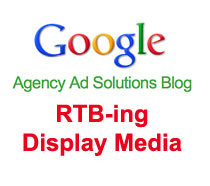 On the heels of a new Google-sponsored Digiday study, Google continues to fan the flames of display as VP of product management Neal Mohan has just published a missive on the Google Agency Ad Solutions blog entitled, “The Three Laws of Display Advertising Physics.” Read more about “the laws.”
On the heels of a new Google-sponsored Digiday study, Google continues to fan the flames of display as VP of product management Neal Mohan has just published a missive on the Google Agency Ad Solutions blog entitled, “The Three Laws of Display Advertising Physics.” Read more about “the laws.”
In the post, Mohan purposefully mixes his metaphors between physics and the financial markets when describing how and why he says clients – particularly agencies – are choosing between a demand-side platform and Google Display Network.
Also, he highlights some sweet stats for real-time bidding lovers including:
- “88% of buyers plan to buy via RTB in 2011, up from 75% last year.”
- “47% of media buyers say that the benefits or RTB will increase their overall digital advertising budget this year (16% said it would not, 37% were unsure).”
- “29% of media intermediaries (such as DSPs, ad networks, and exchanges) anticipate their volume of real-time bidding will increase by 100% or more versus last year. 19% believe it will go up by at least 200%.”
AdExchanger.com spoke briefly with Mohan about specifics on inventory on the Google Display Network and the DoubleClick Ad Exchange.
AdExchanger.com: Can you clarify what inventory is moving through the Google Display Network and being auctioned through DoubleClick Ad Exchange?
NEAL MOHAN: (…) The Google Display Network (GDN) has access to all the inventory that’s in the Exchange. On the supply side of our Exchange is where our millions of AdSense publishers are plugged in as well as inventory that our largest, DoubleClick for Publisher partners choose to put up for auction as well. GDN has access to all of that.
AdExchanger.com: To drill down, the AdSense publishers – save the text-based inventory – is put up for auction through the DoubleClick Ad Exchange?
NEAL MOHAN: One of the things that gets overlooked is that text inventory – to the extent that its running in ad slots that are interchangeable with (graphical) display ads – is also eligible to run through the the Ad Exchange. The beauty of the model is that publishers can configure it whichever they want. (…) The way the Ad Exchange works is that both of those types of inventory formats can be handled in the Ad Exchange.
AdExchanger.com: If you’re buying from DoubleClick Ad Exchange (essentially the “guts” of Google Display Network) through a demand-side platform like Invite Media, isn’t it just like buying an ad network? After all, there is a revenue share agreement between the publisher and Google AdSense or DFP. Wouldn’t you say they’re both ad network models?
NEAL MOHAN: I think there’s a big distinction and that’s why I like the stock broker analogy. (…) One of the big differentiators of Invite Media is the service that we provide -but essentially it’s a white-label service. It’s expert advice, and customer support, and technical insights as needed versus the much more full-service, end-to-end stock broker type model that’s reflected in the Google Display Network. I think that’s not a trivial difference to overlook.
(…) My vision is that the technology on the back end is that it’s about both (audience and context) technologies – both are available through the buying model you prefer. From Google’s perspective we want to provide either one.
Ad Exchange Or Ad Network
DoubleClick Ad Exchange underpinnings seem to remain a publisher ad network on its back end as AdSense grabs fat margins via exchange bidders. – Can’t really blame Google with its competitive advantages of scale and technology continuing to drive the rev share black box on a per impression basis with publishers. Everybody’s making money and as long as that happens, and publishers remain happy, there’s no reason to stop.
Moreover, let’s say Google did start exposing the “charge” to rev share publishers on a per impression basis (e.g. Google came out and said it would take 25% of the revenue of each impression sold) to the buy and sell-sides of the exchange. Would it matter? Again, it would seem as long as liquidity remains strong and drives publisher yield, perhaps not. The competition could start using the publisher “charge” against Google saying we only charge 10% or whatever. (And maybe the buy-side would be more inclined to go “direct” to the publisher?) Yet, real-time biddable tech combined with overwhelming liquidity could overcome the cost issue as, most importantly, yield remains strong.
It’s still early days with RTB, but not as “early” as last year! – looking forward to see this addressable media world go cross-digital-channel with global frequency capping and better attribution for the marketer.
By John Ebbert













